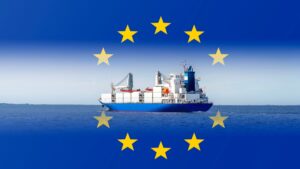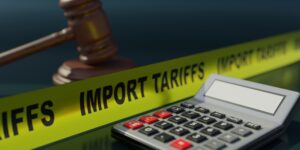WITA’s Friday Exchange Podcast: Bad Ad Vibes and Trade Wars
This week on WITA’s Friday Exchange, trade experts unpack the trade impacts of the Trump–Xi meeting; break down what we know about trade talks with Japan and Korea; deals with Malaysia, Cambodia, Thailand and Vietnam, and other bilateral developments from Trump’s Asia tour.
Featured Speakers:
Introduction: Kenneth Levinson, CEO, WITA – The International Trade Membership Association
Wendy Cutler, Senior Vice President, Asia Society Policy Institute; former Acting Deputy U.S. Trade Representative, Office of the U.S. Trade Representative
Sara Schuman, Managing Director and International Trade Practice Lead, Beacon Global Strategies; former Senior Trade Representative & Minister Counselor for Trade Affairs, U.S. Embassy Beijing, Office of the U.S. Trade Representative
Dawn Shackleford, President, Looking Glass Trade LLC; former Executive Director for Trade Agreements Policy & Negotiations, Department of Commerce; former Assistant U.S. Trade Representative for Southeast Asia, Office of the U.S. Trade Representative
Moderator: Joe Damond, Chair of International Trade Policy and Global Life Sciences, Crowell Global Advisors; former Deputy Assistant U.S. Trade Representative for Asia and Pacific, Office of the U.S. Trade Representative
Watch the Video on YouTube | Listen on Spotify or Apple Podcasts
How China Remade Global Trade — and Then Broke It
Following is an excerpt:
China’s entry into the WTO was hailed by Presidents Bill Clinton and George W. Bush, who hoped integrating hundreds of millions of skilled workers into a rule-based trade order would offer not just economic advantage to the Chinese people, but political liberty, as well. That liberty has largely failed to emerge. A relatively wealthier, globally connected China continues to violate the human rights of its citizens and neighbors, including Taiwan, Tibet, and Hong Kong.
Nor has China’s globalization been without costs for the rest of the world. In Europe, Chinese solar panels sold at below-market prices devastated local producers in Munich and Brussels. The same story repeats in other nations, with electric vehicles, smartphones, semiconductors, prescription drugs, and medical devices. The “China Shock,” as documented by David Autor, David Dorn, and Gordon Hanson, showed how regions of the US exposed to Chinese import competition suffered persistent job and wage losses. Low-skilled workers with no college degree were hurt the most. Consumers benefited from cheaper goods, but voters began to question whether the bargain was fair.
The deeper problem is that China, having gained so much from globalization, began to weaponize it against the very countries that had helped lift its country out of destitution. Subsidy-fueled overcapacity, export coercion, and selective trade retaliation turned economic interdependence into political and military leverage. Neighbors were blackmailed, partners punished, and the global system distorted. Technological tactics have ramped up with psychological warfare to manipulate and influence public opinion.
Washington took notice of these aggressions. Charlene Barshefsky, who had helped represent the Bush administration in admitting China into the WTO, found her initial optimism soured, and recently lambasted previous presidents for not holding China accountable to the WTO’s rules. Donald Trump’s trade war stepped up tariffs — including 100 percent on Chinese EVs — and imposed duties on critical minerals. Europe reacted with its own duties on EVs. Beijing retaliated with tariffs on EU pork (including pig ears, noses, and feet, which are popular in China), targeting exactly the kind of complementary consumption seen in duck necks and chicken racks. Globalization shifted from cooperation to confrontation.
Read the Full Article Here
10/27/2025 | Donavan Lingerfelt & Ma Junjie | The Daily Economy
The Emergence of a New Global Trading Order? Scenarios For Global Trade and The EU’s Role
Following is an excerpt:
In considering scenarios for the global trading system over the next decade, there are three variables to consider: (a) the extent to which the US and China are ready or not to accept certain rules-based guardrails while continuing to engage in geoeconomic competition; (b) the capacity of the rest of the world to act collectively to organise a reformed rules-based trading system that does not depend on cooperation from the two geopolitical rivals; and (c) the capacity of existing institutions –WTO and FTAs– to adapt.
This paper will present three scenarios for the next decade: (a) trade without rules; (b) a fragmented trading order including a coalition for rules-based trade; and (c) a reconstructed global trading system. The third scenario would imply that both the US and China are ready to cooperate in a major reform of existing trade institutions. This is unlikely in the absence of a major crisis that creates the political context for reinforced cooperation and a willingness to undertake domestic adjustments. The main difference between scenarios one and two is the capacity of the rest of the world to agree on a resilient system of rules-based trade. The political feasibility of each of these scenarios depends on the intensity of geopolitical competition, domestic political developments in those countries that have a systemic impact on global trade and the interface between the trade regime and other economic regimes, notably those relating to monetary issues and climate change. What follows is a presentation of the main features of each scenario.
Adam Posen has characterised the new US attitude to the trading system as moving from an insurer to an extractor of profit. This is illustrated by the main features of the ‘deals’ so far concluded by the Trump Administration. These are: (a) an asymmetry of tariff commitments that favours the US; (b) the inclusion in some deals of non-market based one-sided commitment on investments; and (c) the lack of legal stability or of a mechanism for third party adjudication. Such deals are fundamentally inimical not only to the core principles of the GATT/WTO system but also to the carefully designed legally binding trade agreements that have supported the development of global value chains. The US has indeed walked away from all the trade agreements concluded by previous Administrations with the partial exception of the agreement with Canada and Mexico. Moreover, the US is also ready to apply tariffs as a tool to relocate manufacturing industries or as an instrument of coercion for non-trade objectives.
Read the Full Article Here
10/09/2025 | Ignacio García Bercero | Real Instituto Elcano
How Unprecedented are Trump’s “Emergency Tariffs”?
When President Donald Trump imposed his so-called reciprocal tariffs on pretty much all products from all countries this year, he said he was responding to a national emergency due to the nation’s trade deficit. He claimed as authority for his actions the International Emergency Economic Powers Act (IEEPA). The lower courts have ruled against the tariffs, finding that Congress had not delegated to the president sufficient authority to impose them. Their decisions are being appealed to the Supreme Court, with oral argument scheduled for November 5.
Only once before has a president imposed a blanket tariff as an emergency measure. President Richard Nixon declared a balance of payments emergency and imposed a 10 percent import surcharge in 1971. It was upheld by an appellate court in 1975 in the case of Yoshida International, Inc. v. United States. It is universally assumed, including by the lower courts in the current case, that Nixon used the Trading with the Enemy Act (TWEA)—the nearly identical predecessor authority to IEEPA—for the 1971 import surcharge.
However, this reading of history is wrong: Nixon did not claim emergency authority for the measure under TWEA. Nixon claimed authority to impose sanctions under trade agreement laws for the tariffs he put into place.
This difference could matter when the Supreme Court hears arguments on the appeal in November. Since Nixon did not invoke emergency powers under TWEA, a sanctions law, there is no legal precedent for Trump invoking emergency powers under IEEPA to impose his “reciprocal tariffs.”
Looking back at the events of 50 years ago, how did the courts get this important point so wrong? The answer takes some detective work. The planning for the surcharge took place in tight secrecy at Camp David, the presidential retreat in the Maryland woods, over a weekend in mid-August 1971. The administration’s top economic officials were all there, including Secretary of the Treasury John Connally, a trade hawk; Under Secretary for Monetary Affairs Paul Volcker; Federal Reserve Board Chair Arthur Burns; Chairman of the Council of Economic Advisers Paul McCracken; Council of Economic Advisers member Herb Stein; and Peter G. Peterson, serving as the assistant to the president for international economic affairs and executive director of the Council on International Economic Policy. Henry Kissinger, Nixon’s national security advisor, who was not at Camp David, was given such scant information early that weekend that it made little impression on him. Even Secretary of State William P. Rogers was kept in the dark, despite the massive impact the actions would have on US foreign relations. The State Department was not even informed until an hour before Nixon announced the measures on television on Sunday night, August 15, 1971.
Read the Full Publication Here
10/28/2025 | Alan Wm. Wolff | Peterson Institute for International Economics
How Tariffs Hurt The Ones You Love
In early 2025, ruling by emergency decree, US President Donald Trump imposed steep and broad tariffs against the outside world in two waves. The first, beginning 20 February and “paused” on 13 March, targeted Canada, China, the EU, and Mexico. The second wave, President Trump’s “Liberation Day” tariffs, beginning 3 April and “paused” on 8 April, targeted foreign economies in general. In each episode, other countries announced retaliations and the US announced counter-retaliations. In each episode, US market indexes dropped over 10%.
President Trump referred to his Liberation Day tariffs as a “declaration of economic independence [that would mean] Jobs and factories will come roaring back into our country, and you see it happening already.”
Traditional manufacturing – the mainstay of the US economy, from California to Massachusetts, in the 1960s – had been automating and moving labour-intensive supply chain components offshore for decades. New high-technology firms re-energised regions around research universities with well-educated labour pools. Voters in these ‘blue’ regions largely supported the Democratic Party, while voters in left-behind ‘red’ regions largely supported Trump and the Republican Party. The colour-coding reflects the rival parties’ campaign ads, flipping the traditional Marxist red versus Tory blue.
President Trump’s prediction suggests the broad market declines in the two tariff rollout windows might obscure rising stocks of firms in manufacturing and other traditional sectors, especially those headquartered in ‘redder’ regions. To test this, we assess each firm’s ‘redness’ by the number of votes for Trump per vote against him in the firm’s headquarter county in the 2024 presidential election.
We find the opposite: the stocks of US firms headquartered in ‘redder’ counties fell more, especially during the Liberation Day wave of tariff announcements. Stock indexes for industries with more firms headquartered in ‘redder’ counties also fell more.
Measures of investor fear rose to historically rare heights in both tariff waves, so the plummeting stock valuations appear to reflect some mix of investors’ lower expectations and heightened fears about the future prospects of firms headquartered in redder counties. Regardless, the pattern does not support the contention that tariffs looked better, or even less bad, for firms or industries based in redder counties.
Read the Full Column Here
10/28/2025 | Janice Huijun Yan & Randall Morck | Centre For Economic Policy Research
WITA – We put the community in trade community.
Information about upcoming WITA and trade community events






